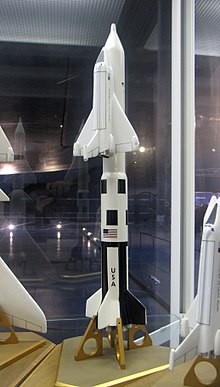Saturn shuttle
| Saturn shuttle (project discontinued) | |
|---|---|
| Orbiter | |
| Takeoff mass (maximum) | 2,304,000 kg |
| Payload in LEO | Max. 60,500 kg |
| crew | 8 people |
| Launcher | modified Saturn V |
The Saturn shuttle is the concept of an American orbital rocket. A modified, winged and recyclable rocket stage Saturn-IC (S-IC) was intended to be used as a booster for the space shuttle .
When Grumman / Boeing , Lockheed , McDonnell Douglas and Rockwell were unable to keep the budget for the development of the space shuttle in 1971, options were sought to reduce development costs: The "Saturn Shuttle" was the combination of the first stage of the Saturn V , the S-IC called the Space Shuttle Orbiter.
A memorandum about this combination was drawn up in 1969 at Bellcom , a planning company commissioned by NASA . The engineer C. Eley investigated how an Orbiter / S-IC combination could be maintained and started. He came to the conclusion that the S-IC could fulfill its function as a booster almost unmodified.
The "Saturn IC" used as a booster would have been recyclable, with the exception of the F-1 engines. However, since this disadvantage was considered unacceptable, the study was not pursued any further and separate boosters were developed.
See also
Web links
- Saturn Shuttle in the Encyclopedia Astronautica (English)
Individual evidence
- ^ David SF Portree: The LUT, the Shuttle, and the Saturn V S-IC Stage (1969). Wired.com, April 13, 2012, accessed November 26, 2014 .
